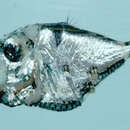en
names in breadcrumbs


View data on Catalog of Fishes here.
Dorsal-fin rays 14–16 (rarely 17); anal-fin rays (rarely 15) 16–17 (rarely 18); pectoral-fin rays (rarely 12) 13–14 (rarely 15); gill rakers 20–23 (rarely 24); vertebrae 32–33. Large to giant species, often exceeds 70 mm SL; body relatively broad, tapering evenly to narrow but short caudal peduncle, its greatest depth greater than length of subcaudal photophores; posttemporal and dorsal spines short (less than one-fourth eye diameter); preopercle spine very short, triangulate; abdominal keel scales extend slightly below ventral body margin; first supra-anal photophore markedly lower than second; first supra-abdominal photophore raised well above other two, second and third supra-abdominals usually about same height; jaws medium to large; teeth minute; gill rakers medium to long, spinose on internal surface; in preservative, pigment dark dorsally; dark pigment bar extends toward but never reaches midline; lateral border of dark dorsal pigment straight from dorsal spine to caudal peduncle; dark pigment spots lateral midline, pigment striations present on trunk.
Post-temporal spine simple, bearing no basal spines; lateral edge of post-temporal-supracleithrum smooth; keel scales with smooth ventral surfaces; supraanal photophores separate, usually raised well above anal group. Post-temporal spine short, its length less than one-fourth the diameter of orbit; anal photophore number 7 to 9; body robust, less than 1.9 times body depth; first supra-anal photophore markedly lower than second. Teeth absent on posterior vomerine shaft; second supra-anal photophore even with or raised above third; supra-abdominal photophores nonsymmetrical, first photophore raised well above other two. Gill rakers to 24; dorsal rays 14 to 16; lower margin of dark dorsal pigment straight from dorsal spine to caudal peduncle. Anal pterygiophore margin essentially straight; anal photophore number 9 (rarely 10); greater than 3.7 times body depth at end of dorsal
Restricted to the western North Atlantic; abundant in the Caribbean and Gulf of Mexico from the coast of Venezuela to the straits of Florida; off the outer islands of the West lndies and less abundantly along the east Coast of North America; a single capture bas been reported as far north as the Gulf of Maine.
Baird RC. 1971. The Systematics, Distribution, and Zoogeography of the Marine Hatchetfishes (family Sternoptychidae). Bulletin of the Museum of Comparative Zooology 142(1):1–128.
Baird RC. 1971. The Systematics, Distribution, and Zoogeography of the Marine Hatchetfishes (family Sternoptychidae). Bulletin of the Museum of Comparative Zooology 142(1):1–128.
Exceed 70 mm SL.
18°29'45"N, 65°25'50"W to 18°35'30"N, 65°23'54"W, Caribbean Sea, depth 200-400 fathoms.
Holotype: USNM 102979
Polyipnus asteroides, commonly known as the shortspine tenplate, is a species of ray-finned fish in the family Sternoptychidae. It occurs in deep water in the western Atlantic Ocean from the Gulf of Maine southward to the Caribbean Sea and the Gulf of Mexico. It occurs to a depth of about 500 metres (1,600 ft).[1]
Polyipnus asteroides, commonly known as the shortspine tenplate, is a species of ray-finned fish in the family Sternoptychidae. It occurs in deep water in the western Atlantic Ocean from the Gulf of Maine southward to the Caribbean Sea and the Gulf of Mexico. It occurs to a depth of about 500 metres (1,600 ft).